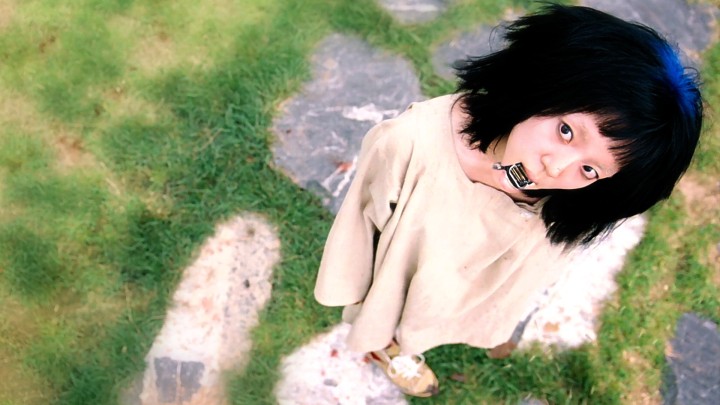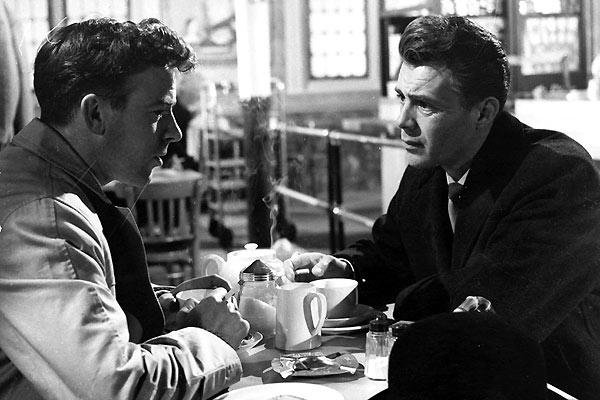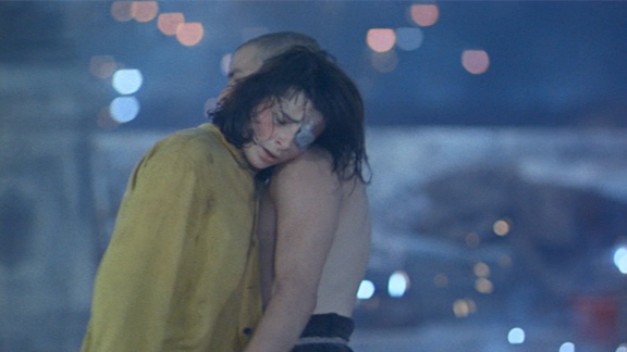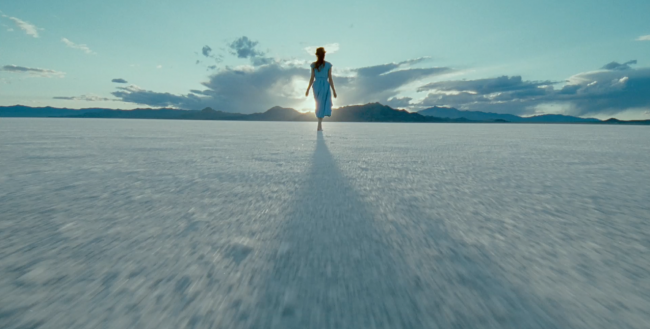#67. I’m a Cyborg, But That’s OK (2006, Park)
A major departure for Park in subject matter, but his form and execution remain astutely his. Favoring the subjective, Park Chan-wook’s romantic asylum film works because he stays loyal to his deluded characters. One of the quirkiest films I’ve ever seen, it sometimes becomes overloaded with eccentricities and whimsy, but always bounces back to remind us that cutesy is not the name of the game. Each patient lives in their own universe, and Park unites them under his roof of his and Chung Chung-hoon’s camera, delighting in what makes them unique.
I love when the film goes off on tangents with the various residents, seamlessly moving between different perspectives, bringing their delusions to life. The central pair (one of whom is adorably played by Rain), are connected through their troubles, but the romance thankfully never tips into the straight-forward. Not even once. Park’s camera glides around, attentive as ever, always impeccably placing people within the frame, playing around with distance and relation. His hospital is filled with pop colors, a vibrant playground for the troubled where even the nurses and doctors barely register. I’m a Cyborg, But That’s OK lets the characters keep their elaborate inner worlds, using reality only add the necessary dose of underlying sadness.
#68. Samaritan Girl (2004, Kim)
Samaritan Girl reminds me that I need to see all of Kim Ki-duk’s films even though this is probably my least favorite of the three I’ve seen. A triptych telling of a story, Kim, himself a Buddhist, weighs this film down in Catholic imagery and symbolism. It starts out about one character, shifts to another and then beings the two together for the final third which shows a breakdown in communication. A father and daughter who have dealt with grief and betrayal in equally misguided ways and can’t even come together to console each other. Kim retains the innocence of the girls involved in prostitution. He allows them to be schoolgirls, one possibly in love with the other. He veers into male fantasy territory in the way he retains this innocence and the at times oversimplification of the two girls. A lot of this is made up for by the fact that the oversimplification is part of the girls varying coping mechanisms.
Kim is a divisive provocateur, known for his challenging material and the way he marries peaceful stoic imagery with extremes in content. Samaritan Girl continues this fascination. Stunning lead performance by Kwak Ji-min.
#69. Victim (1961, Dearden)
An important film that addresses the Sexual Offences Act in England and Wales, which lasted through to 1967, making homosexuality illegal. Humanizing homosexuality, being the first film where the word is spoken, and being told from the perspective of homosexual characters being tormented with blackmail and driven to suicide…all of this is pretty groundbreaking stuff. Yes, it often treats homosexuality as an it-can’t-be-helped-abnormality but it’s a product of the time, and there’s a ton of progressive rationalization going on in support of all the horrible LGBT social injustices still running rampant today.
But despite being a well-shot social problem film with a simmering lead performance by Dirk Bogarde, I wasn’t grabbed by the story or the characters. It interested me more for what it stood for but sadly it didn’t engage me.
#70. The Cat and the Canary (1927, Leni)
You guys, Paul Leni is seriously underrated. I don’t think cinephiles give him his imagine-what-he-could-have-done due. The man died at 29 but was one of the key figures in German Expressionist filmmaking of the silent era. He brought his experimental distorted spook-fest techniques to Hollywood where he made a handful of films before dying in 1929 via blood poisoning. He also made one of my favorite films of the silent era, The Man Who Laughs. If you haven’t seen it, DO SO.
The Cat and the Canary doesn’t quite live up to the high standard of The Man Who Laughs, entirely because the film focuses too much on comedy instead of being pure haunted house horror, which I would have preferred. It being adapted from a horror-comedy play, it looks like Leni was kind of trapped as a result (whether he liked the material or not), mostly in the latter half. But Paul Leni’s magic bag of visual bedazzle is more than up to par. He does everything you can imagine, fooling and tinkering with the possibilities of the moving image to unsettle and splay the unconscious. Experimenting with point-of-view, distorted imagery, superimposed images, angles and set design, intertitles, tracking shots, etc; all of it and more. The result is that you feel the characters are caught in a haunted house illustration. The first half juggles comedy and horror really well, but the second half peters out in favor of comedy. Sad sack Paul Jones is our ‘hero; but he’s such a low-down dweeb that I was unrealistically hoping the film would pull a twist and make him the ‘Cat’. No such luck. And our ‘heroine’, Annabelle West literally has nothing to do. The entire duration has her insisting upon her sanity whilst becoming increasingly unstable. Surprise, surprise. She’s inactive from start to finish. And I lost track at just how many envelopes come into play at a certain point. So many envelopes.
But this is still enjoyably kooky and worth watching multiple times for Paul Leni’s unnerving expressionist playground.
#71. The Crowd Roars (1932, Hawks)
Review: https://cinenthusiast.wordpress.com/2013/03/30/review-the-crowd-roars-1932-hawks/
#72. You Can Count On Me (2000, Lonergan)
Playwright Kenneth Lonergan’s film debut takes a middle-of-the-road indie set-up and propels it to restrained insightful heights. I love sibling films, particularly films that explore brother/sister or sister/sister dynamics. There aren’t as many of them as there should be and they often fall through the cracks of mediocrity. But this one is deftly handled, looking at a brother and sister who lead disparate lives, depending on each other in a multitude of ways even as they push back. Their infinite grief over their parents death when they were children forever-defines and binds them as they navigate through what they may or may not want in life.
Laura Linney is prime cut for her role and Matthew “I like paperwork” Broderick is perfect casting but its Mark Ruffalo who really knocked my socks off. He’s played the irresponsible drifter before, but this is his bursting-on-the-scene role, and he plays on his ability to emit the kind of sympathy you’d have for a child. He makes you understand why Linney, besides the familial bond, constantly babies him and gives him chances. Almost as dramatically rewarding as the Linney/Ruffalo interactions are those between Mark Ruffalo and Rory Culkin. Longegan very smartly has Culkin underplay, so he’s never pulling at heartstrings and always quiet and observant, trusting the audience to understand the impact this is all having on him.
Lonergan mixes the humorous and the reflective together with well-timed perception. The scene between Ruffalo, Linney and Lonergan himself as a useless priest perfectly toes the line. Another stand-out scene, more on the serious side, is when Ruffalo and Linney meet up in the café. It’s their first scene together. She is ecstatic to see him, gleaming, and he’s happy to see her. It’s been two years. What starts as hesitant how-do-ya-dos quickly gives way to the ‘I’ve been in some trouble’ speech on guess-who’s part. A confession we see coming and even worse, deep down so does she. We realize this is a sort of cyclical conversation, raised from the grave every so often, rehashed but never resolved. Her giddiness to see him was authentic but also a front of self-denial. Maybe this time it will be different.
Also; yep, I cried during this one. Didn’t expect to, but the bench scene got me going.
#73. Les Amants du Pont-Neuf (Lovers on the Bridge) (1991, Carax)
An exuberant burst of swirly fuzzy lights, as if we are seeing life through the eyes of Binoche’s going-blind street artist, taking life in in one last hurrah. Leos Carax makes a preposterously expensive (it’s well-known for its notorious production history as anything) ambitious love letter to Paris, that shouldn’t be oversimplified at least in his at-first glance adoration with the city. As far as content goes, this is a simple tale, one where a plot synopsis makes it sound limp and trite. But its simplicity, which favors broad and often startling poeticism, sends Carax careening with the kind of cinematic indulgence that sends me off to the stars. Starting in a pit of real-life gutter-poverty and slowly rising until the worlds of Alex and Michele feel strangely comfortable to us, misery and self-destructive tendencies included. Jean-Yves Escoffier’s camerawork is something majestic, always getting the grime and fantasy to mesh together in the same shot. He keeps up with the physical bursts of movement from Binoche and Denis Lavant, including their stunt work (Binoche’s waterskiing looked seriously life-threatening). Lights streak into each other, a semi-blind haze.
The freedom afforded by any rigid structure and the way Carax matter-of-factly handles events with no build-up, means we can never quite tell where the film is going, making it all the more engrossing. The tone is constantly shifting in subtleties and the relative enigma of the characters positions them in their own lore. The film even somehow rises above the problematic actions on Alex’s part, which in another film would destroy any semblance of attachment we have to the idea of them as ‘lovers’. What I love is that for most of the film is appears resolutely one-sided, more a dependent convenience for her than anything else. I can never take my eyes off Lavant, his acrobatic chimera grotesquery is something elemental. I could willfully digest any number of scenes again and again, and the famous fireworks sequence is bananas, the height of extravagance. I know I’m far from the first to point this out, but there are a lot of parallels to L’Atalante. It’s a force of questionably romantic, squalid, indulgent, joyous, raucous, unapologetic nature.

























